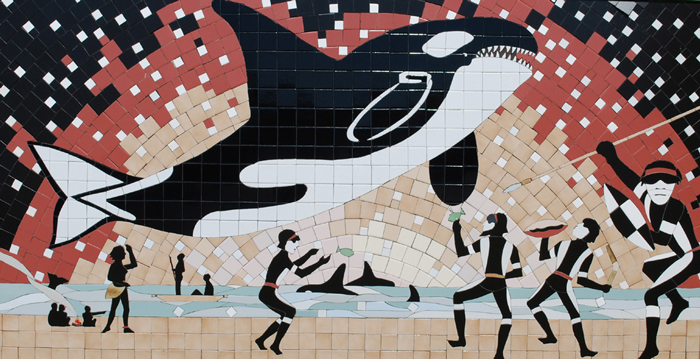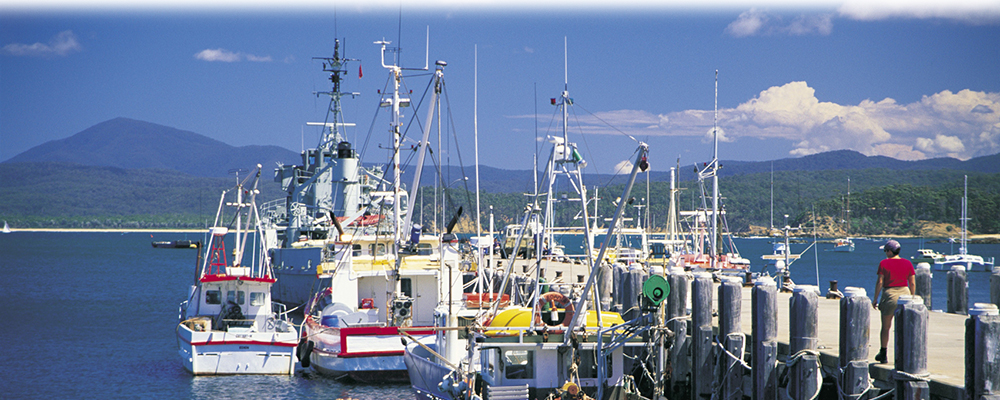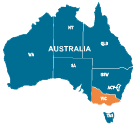Eden History
A Brief History of Eden

A particularly beautiful area of the NSW Far South Coast originally settled by whalers and now a fishing port and a popular, but relatively undeveloped, holiday resort town. Eden, located 476km south of Sydney, is the last town of any significance before crossing the border into north eastern Victoria. With a population of just over 3,000, it is situated 50m above sea level upon undulating land on a point that juts out into Twofold Bay. This idyllic coastal town is bounded to the north and south by National Park and by woodland to the West.
It is thought the area was inhabited by the Thawa Aborigines prior to white settlement. George Bass noted Twofold Bay in December 1797 as he traveled south down the NSW coast. On his return in early 1798 he entered the Bay he named Snug Cove for the security to shipping it afforded. It is here that the Eden Wharf now stands.
Later in 1798 Bass set off again for Van Diemen’s Land with Matthew Flinders, this time making a detailed and accurate survey of Twofold Bay. It was during this survey that Bass and Flinders made contact with local Aborigines. Flinders offered them some biscuits and received some fat (probably whale fat) in return. After tasting it Flinders recorded that while ‘watching an opportunity to spit it out when he should not be looking, I perceived him doing precisely the same thing with our biscuit’.

The early history of the Bay is closely tied to the whaling industry and it is in recognition of this that the inaugural Eden Whale Festival was held in October 1996. The first whales were killed as early as 1791. The migration of these animals (mostly Right Whales) to and from the Antarctic waters took them past Twofold Bay between May and November of each year.
Commercial exploitation commenced in the early years of the 19th Century when whaling ships took shelter in the Bay from inclement weather, subsequently using it as a base for operations.
The first white settlement was made by John Raine in 1828 when he established the first shore whaling station on mainland Australia.
In the early 1830’s the three Imlay Brothers followed suit, training local aborigines as whalemen. The Brothers, major pioneers of and landowners in the district, moved to Australia from Scotland between 1829 and 1833. Peter, the oldest and second to arrive, first visited Twofold Bay around 1833 and decided to live there. Followed by George they soon turned to cattle rearing, which they shipped to Tasmania, South Australia and, later, New Zealand. They erected Eden’s first, albeit modest, building, a small slab and bark hut at Snug Cove. Unfortunately the depression of the 1840’s broke the family financially. The Walker Brothers, merchants of Sydney, foreclosed on the Imlays’ and acquired the land.

A particular group of killer whales visited the area each year, using the south of the Bay as their base for the season. Locals, recognising them by distinctive markings, assigned them individual names and found them to be a great help in hunting and bringing whales into the Bay.
The killer whales hunted in packs like wild dogs, driving the whales into shallow water, preventing their escape to deeper waters and attempting to frustrate their attempts to take in air. Apparently the killer whales, if they detected whales about, would travel to the whaling station, make a great deal of noise, wait for the boats to launch and then lead them to the whales.
The combination increased the certainty of a kill, ensuring a meal for the killer whales. They fed almost exclusively on the lips and tongue of the whales, leaving the blubber etc for the whalers.
Eden was named after the British Secretary for the Colonies, Baron Auckland, whose family name was Eden. Although permission was given for the establishment of a township at Twofold Bay in 1834 the town was not laid out until 1843.
Apart from whaling, which died off in the late 1920’s, wattlebark (a source of tannin) and, to a lesser extent, dairying and brick making, were the main industries in the early days of white settlement.
The exploitation of timber, now a principal source of income for the town, came to prominence at the outset of the 20th Century due to the demand for railway sleepers. These were shipped to China from Snug Cove and, later, to Germany and New Zealand as well as being used locally.
Commercial fishing, now another staple industry for the township, had been carried on for many years but it was not until tuna canning commenced in 1949 that business took off.
Benjamin Boyd

“Benjamin Boyd (1801 - 1851), by unknown artist, courtesy of Herald & Weekly Times Portrait Collection, State Library of Victoria. H38849/448.”
Benjamin Boyd, born on the 21st August 1801 in London, was the second son of Janet and Edward Boyd, a London Merchant of Merton Hall, Wigton Shire, Scotland. Boyd spent his early years in Scotland near the small town of Newton Stewart.
In 1825 Benjamin Boyd became a member of the London Stock Exchange where for 15 years followed shipping and commercial opportunities available in the State.
On the 8th October 1840, Boyd addressed a letter to Lord John Russell stating that he had recently dispatched a vessel (the Seahorse Paddle Steamer) for the purpose of trading in Australian waters. He also stated that he intended to send other vessels and asked for certain privileges in the connection with the purchase of land at various ports he intended to establish. He received a guarded reply promising assistance, but pointing out that land could not be sold to an individual to the “exclusion or disadvantage of the public”.
Boyd’s bold response to this was to float the “Royal Bank of Australia” in hopes it would help finance his operations. The banks total nominal capital was worth around one million pounds with Boyd gaining a raised venture capital of approximately 200,000 pounds. Boyd also formed the “Australian Wool Company” within which 15,000 pounds of its in debentures were deposited with the Royal Bank.
In 1841, backed by the “Royal Bank of Australia”, accompanied by brother James Boyd, artist and friend Oswald Brierly and a crew of 14, Boyd set sail for Sydney aboard his luxury schooner the “Wanderer”, a unit of the Royal Yacht Squadron. Boyd arrived in Sydney on July 18, 1842.
Boyd lost no time launching his various enterprises and investing his own and his banks money. He quickly put the paddle steamer “Seahorse” into operation as he believed steamships were required to help serve the needs of the South Coast and that settlers’ were reliant upon sea travel. The “Seahorse” began service between Sydney, Melbourne and Launceston.
In December 1842, during a voyage from Sydney to Melbourne, Boyd and his party remained in Twofold Bay while the paddle steamer “Seahorse” returned to Sydney for repairs to a damaged piston. It was during this short stop over that Boyd recognised Twofold Bay’s potential and immediately set to work planning a self sufficient township.
Within 2 years of his arrival, Boyd had become one of the largest land holders in the colony with nearly 2.5 million acres in the Riverina and Monaro regions upon which grazed 158,000 sheep and 21,000 head of cattle.
Boyd decided that Twofold Bay would serve as the coastal base for his enterprises through which he could ship livestock, wool and tallow from the Monaro Hinterland.
In 1843 constructions of Boydtown commenced, which involved the building of a 300 foot long jetty, a lighthouse, a church, convenience stores, brick houses and an Elizabethan style Hotel. Boyd hoped that one day Boydtown would become the Capital of Australia.
Shore whaling and the related oil extraction process had been established in Twofold Bay for approximately 15 years, Boyd seeing potential in this added both of these to his list of enterprises, undertaking the settlement of East Boyd for his purpose and building a salting and boiling down works at Boydtown.
Boyd was a firm believer in low wages for his employees and due to this had difficulty finding recruits for his various enterprises. His solution was to import natives from the Pacific Islands in 1847 as a source of cheap labour. However due to objections from liberals, humanitarians, and the Australian labourers, who saw a threat to their own interest, most of the Islanders had returned home by the end of the year.
The extensive expenditures required for establishing Boydtown soon began to weigh heavily against Boyd’s assets. He had overreached himself with his investments and to make matters worse, the “Seahorse” had been irreparably damaged after striking a rock in 1843 and his other business ventures had been adversely affected by drought and the depression of the 1840’s.
By 1847 the financial situation was so serious that Boyd was removed from the control of the enterprise and by 1849 the liquidators were called in and operations in Twofold Bay ceased.
The enterprise had closed with most of the buildings (Seahorse Inn and Church) incomplete; Boyd’s whole colonial endeavour a fairly spectacular failure. On October 26, 1849 Boyd set sail on the “Wanderer” and left Sydney harbour unnoticed. In a parting legacy he writes to an associate, a parting legacy to the colony in which I had hoped for so much, and although in part succeeded, yet on the main failed through little of my own fault.
Boyd left Australia to re-establish his fortune in the Californian Goldfields, but failed. Moving on, Boyd explored various islands of the Solomon group, with the idea of establishing a Papuan Republic.
On October 15,1851, accompanied by a native he went ashore on San Cristobal Island to shoot game, and disappeared.
An investigation found only a deserted row boat, a gun and numerous footprints indicating a struggle. In 1854, after rumours circulated that Boyd was still alive and being held prisoner on the Island, an expedition was sent to make further enquiries, but they proved to be fruitless and to this day nothing has ever been proven as to his fate.
One month after Boyd disappeared, on November 13, 1851 the “Wanderer” was wrecked in a gale off Port Macquarie. One of the ships crewman noted, It seemed as though an evil fortune brooded over the yacht; and in one short month after the death of him whose pride she had been ............ the wanderings of the “Wanderer” were at an end.
The Seahorse Inn

The principal relic of Boyd’s adventures is the Seahorse Inn. It began construction in 1843 however, symbolic of Boydtown itself the Hotel was built of convict labour and was never fully completed.
It was abandoned in 1849 and for almost an entire century was left vacant, reduced to a mere shell due to vandalism and deterioration.
In 1936 it was purchased by the Whiter brothers who renovated it and later added a second story.
In 1975 Bruce Lyon purchased the Seahorse Inn and continued to restore it throughout the 1980’s and 1990’s.
In 2002 he closed the Inn down and spent a considerable amount of time renovating and refurbishing the old Hotel. He added the Brassiere and Conference rooms onto the original building and transformed it into the beautiful Hotel it is today, so that it could once again stand proudly on the shores of Twofold Bay.
The foundation of the Inn was made of sandstone from Pyrmont in Sydney, lugged from the shore to the site by bullock wagon. The rest of the Hotel was constructed of local stone, thousands of red brick (from clay quarried nearby) and pit sawn hardwood, with cedar and oak fittings from England.
Perched on a ridge near the Inn are the ruins of the old church. The church was built complete with shingled roof, however the bell tower and floor was never finished. It is recorded that the roof of the church was burnt in the fire of 1926. The church was never consecrated or used.
Boyd's Tower

Boyd’s Tower built on the headland south of Twofold Bay was built between 1846 and 1848. It was intended as a lighthouse and a lookout for whales.
Like most things associated with Boyd, it was never fully completed and permission for its use as a lighthouse was refused, due to the fact that Boyd wanted to use the lighthouse for his ships only. It did however serve as a great whale spotting site, giving Boyd an edge over his competitors.
The walls and the stone work at the crest of the tower were finished, however lightening has dislodged some of the latter.
The letters B-O-Y-D are clearly chiselled into the stones forming the apex of the tower. The woodwork of the internal staircase has been destroyed.
The tower was designed by Oswald Brierly, an English artist and student of Naval Architecture, who accompanied Ben Boyd over to Australia.
Oswald Brierly
Brierly lived at Twofold Bay for some five years acting as a sort of manager / superintendent of the whaling site at East Boyd. Brierly’s cottage in East Boyd was situated where Edrom Lodge stands today.
Years later he was appointed official Marine Painter to Queen Victoria and was subsequently knighted.
Alexander Davidson
Alexander Davidson, together with his wife Jane and seven young children, arrived in Australia from Scotland in 1842, and the following year moved from Miller’s Point Sydney, to Boydtown, in answer to an advertisement calling for carpenters and joiners to work on the Seahorse Inn.
After Boyd’s departure, Alexander worked at Inn Keeping and gold mining before the family commenced what was to become one of the most fascinating chapters in Australian maritime history.
With boats purchased from George Barclay and Solomon Solomons along with other equipment from Boyd, Alexander and his sons commenced shore based whaling by re-building an old station and try works. Located at the mouth of the Kiah inlet, they operated over four generations, eventually becoming the oldest continually run shore-based whaling station in Australia.
One of the most fascinating aspects of the Twofold Bay whaling story, however, was the role played by pods of killer whales. From at least 1843 until 1930, these amazing creatures returned annually to Leather Jacket Bay and played their unique part in the whale chases of the area. Indeed, Brierly noted the presence of the killers, as they became known, in his 1843 journals.
The killers played an instrumental role in the long survival of the Davidson Station. After herding migrating whales into the Bay, these creatures then combined with the whalers to attack the prey, snapping at their body and throwing themselves over the whale’s blowhole until they finally succumbed to what was almost always an inevitable result. They were even known to alert the whalers to their quarry’s presence by flop tailing and splashing in the Bay in front of the Station. They were rewarded for their assistance with lips and tongues after the whalers had killed the prey.
The Sydney Mail reported on this strange relationship in 1903, commenting:
When a whale is passing North it is driven into Twofold Bay by whales known as the killers ..... When the whales succeed in driving the whale into the Bay they leave off the attack and wait for the whale boats to come. Any attempt the whale makes to go out to sea the killers resent with all energy by snapping pieces out of it ... all the time the killers are at work
The intelligence of the killer whales was aptly demonstrated by “Tom” in 1926 following the drowning death of Jack Davidson and two of his children. Despite a search that continued for more than a week, Jack’s body remained missing, but all the time “Tom” continued to swim around the area where their boat had capsized. It was there that the body was eventually found.

Shore-based whaling at Twofold Bay had finally ended by 1930, just over a hundred years after it commenced. The final farewell to the unique relationship between whalers and killer came in September 1930 when the last of the pod “Old Tom” was found dead in the Bay. He was eventually towed ashore, his skeleton cleaned and mounted and placed on public display. This saw the birth of the Eden Killer Whale Museum and “Tom” remains one of the most popular exhibits on show even today.






